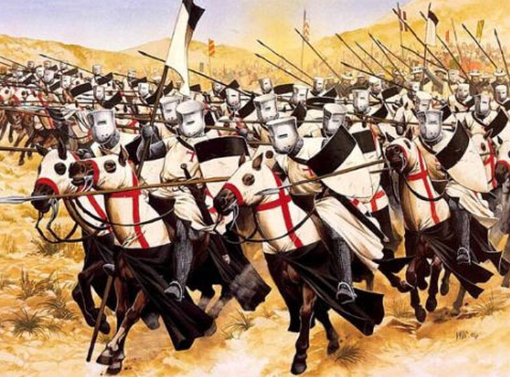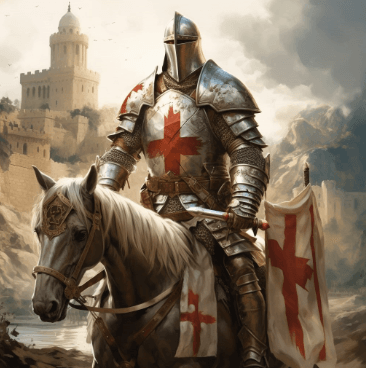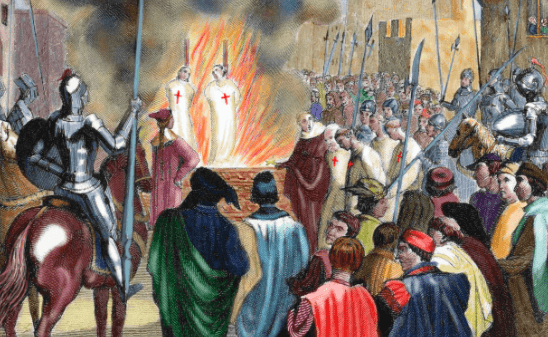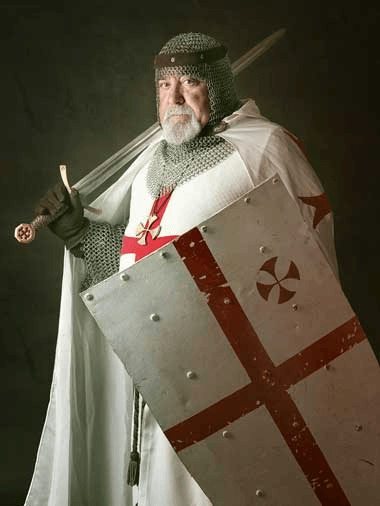
Delve into the enigmatic history of the Knights Templar, a medieval order shrouded in mystery and legend. These warrior-monks, sworn to protect Christian pilgrims in the Holy Land during the Crusades, amassed immense wealth and power before facing a dramatic downfall. Uncover the secrets of their initiation rituals, financial acumen, and alleged hidden treasures that continue to capture imaginations worldwide.
Discover the enduring allure of the Knights Templar as we explore their historical significance, from their humble beginnings to their tragic demise. Join us on a journey through time to unravel the myths and truths surrounding this iconic order of knights.
Key Takeaways
- Understand the origins and rise of the Knights Templar, tracing their journey from humble beginnings to becoming a powerful and influential force.
- Explore the daily life and hierarchical structure within the order, shedding light on the roles and responsibilities of its members.
- Delve into the Crusades and battles fought by the Knights Templar, showcasing their military prowess and strategic importance in historical conflicts.
- Learn about the financial innovations pioneered by the Knights Templar, such as early forms of banking and international monetary systems.
- Appreciate the quest for holy relics undertaken by the Knights Templar, highlighting their spiritual motivations and dedication to sacred artifacts.
- Reflect on the downfall and arrests that led to the eventual dissolution of the order, examining the political intrigues and controversies surrounding their demise.
Origins and Rise
Founding Years
The Knights Templar were established in 1119 by Hugh de Payens and eight fellow knights. Initially, their purpose was to protect Christian pilgrims traveling to Jerusalem.
They were officially recognized by the Catholic Church in 1129 at the Council of Troyes. This recognition granted them special privileges, including exemption from local laws and taxes.
Rapid Expansion
Rapidly expanding, the Templars amassed wealth through donations and land acquisitions across Europe. They introduced innovative financial techniques, such as early forms of banking, which further boosted their influence.
Their military prowess became renowned during the Crusades, where they played a key role in battles against Muslim forces. The Templars’ strategic acumen and bravery earned them respect on the battlefield.
Architectural Legacy
Architecturally, the Templars left a lasting impact with their distinctive fortresses and churches. Notable examples include the Temple Church in London, designed to resemble the circular Church of the Holy Sepulchre in Jerusalem.
Their architectural style often featured elements inspired by Byzantine and Islamic designs, reflecting their exposure to diverse cultures during their time in the Holy Land.
Downfall and Dissolution
Despite their power and influence, the Knights Templar faced a sudden downfall in the early 14th century. King Philip IV of France, heavily indebted to them, orchestrated a plot accusing them of heresy and other crimes.
In 1307, many Templars were arrested, tortured, and eventually executed. Their assets were seized, leading to the dissolution of the order by Pope Clement V in 1312.
Daily Life and Hierarchy
Templar Code
The Knights Templar strictly followed a code of conduct known as the Rule of the Order. This code emphasized poverty, chastity, and obedience.
Roles and Responsibilities
The daily life of a Knight Templar was structured around their roles within the order. They were divided into three main classes: knights, sergeants, and chaplains.
Knightly Duties
Knights Templar spent their days training in combat, managing the order’s finances, and attending religious services. They were skilled warriors and played a crucial role in protecting pilgrims traveling to the Holy Land.
Hierarchy within the Order
The Knights Templar had a strict hierarchy with the Grand Master at the top, followed by officers such as Marshal, Seneschal, Drapier, and Commander of the Kingdoms.
Living Quarters
Each Templar had his own sleeping quarters but shared common areas for dining and prayer. The living conditions were modest, reflecting their vow of poverty.
Financial Operations
One unique aspect of Templar daily life was their involvement in banking. They developed an early form of banking system that allowed pilgrims to deposit money in one location and withdraw it in another.
Crusades and Battles

Knights in Battle
Knights Templar played a crucial role during the Crusades. They were skilled warriors, known for their bravery and strategic prowess on the battlefield. These knights fought in various battles across the Holy Land, defending key Christian territories.
The Battle of Montgisard in 1177 was a significant event where a small force of Knights Templar, led by King Baldwin IV, defeated a much larger Saracen army. This victory showcased the exceptional combat skills of the knights and their unwavering dedication to protecting the Christian states.
Siege Warfare
During the Crusades, Knights Templar were involved in numerous sieges, utilizing their expertise in siege warfare to capture or defend fortified cities. They employed innovative tactics such as building siege engines, mining tunnels under walls, and using catapults to breach enemy defenses.
In 1244, during the Siege of Jerusalem, Knights Templar valiantly defended the city against overwhelming odds but eventually succumbed to the superior forces of the Khwarazmian Empire. This event marked a turning point in the history of Jerusalem and dealt a blow to the Crusader presence in the region.
Naval Battles
Apart from land battles, Knights Templar also participated in naval battles during the Crusades. They operated fleets in the Mediterranean Sea, engaging in naval warfare to secure vital sea routes and protect coastal territories from enemy incursions.
At the Battle of Damietta in 1219, Knights Templar ships played a crucial role in supporting the Fifth Crusade’s campaign in Egypt. Their naval prowess helped transport troops and supplies, enabling effective coordination between land and sea forces for strategic advantage.
Legacy of Valor
The valor displayed by Knights Templar in various battles left a lasting legacy that resonates through history. Their commitment to defending Christendom against its enemies earned them a reputation as formidable warriors dedicated to upholding noble ideals.
Despite facing formidable adversaries and challenging circumstances, Knights Templar remained steadfast in their resolve to protect Christian interests during the tumultuous era of the Crusades. Their contributions to military campaigns significantly influenced the outcomes of key historical events.
Financial Innovations

Banking System
The Knights Templar are renowned for pioneering a sophisticated banking system during the medieval era. They introduced letters of credit, allowing pilgrims to deposit funds in their home country and withdraw them at their destination.
Their banking practices included issuing loans to monarchs and nobles, effectively becoming early international bankers. This financial innovation facilitated trade and pilgrimage across Europe and the Holy Land.
Wealth Management
Knights Templar were adept at managing vast wealth accrued through donations, bequests, and business dealings. They developed investment strategies in land, agriculture, and various industries to increase their financial holdings.
Their meticulous record-keeping enabled them to efficiently oversee their assets spread across different regions. This strategic approach to wealth management set them apart as shrewd financiers of their time.
Economic Influence
The financial innovations of the Knights Templar extended beyond banking and wealth management. They played a significant role in shaping the economic landscape of medieval Europe through innovative financial instruments like promissory notes and banking facilities.
Their network of preceptories acted as economic hubs, facilitating transactions, investments, and trade agreements. This influence contributed to the growth of commerce and finance during the Middle Ages.
Quest for Holy Relics

Sacred Mission
The Knights Templar embarked on a sacred mission to recover holy relics during the Crusades. Their quest aimed to locate and safeguard significant religious artifacts.
They believed that possessing these relics would grant them divine favor in battle, reinforcing their resolve and inspiring awe among their enemies.
Notable Discoveries
Over time, the Knights Templar made notable discoveries, including relics like the Holy Grail and pieces of the True Cross. These findings enhanced their reputation as protectors of Christianity.
Their success in acquiring such revered artifacts solidified their position as key players in the medieval world’s religious landscape.
Legacy and Influence
The pursuit of holy relics by the Knights Templar left a lasting impact on history. Their dedication to this cause showcased their unwavering commitment to preserving Christian heritage.
Moreover, their efforts contributed to the preservation of valuable religious treasures that continue to captivate historians and archaeologists today.
Downfall and Arrests

Templars’ Disbandment
The Knights Templar faced a significant downfall in the early 14th century. King Philip IV of France, facing financial debts to the order, orchestrated a plan to bring them down.
Amidst false accusations of heresy and blasphemy, the Templars were arrested on Friday, October 13, 1307. This event led to widespread arrests across France and beyond.
Trials and Dissolution
Templar leaders endured brutal interrogations, leading to confessions extracted under duress. The trials that followed were marred by coercion and torture, with many knights admitting to false charges.
In 1312, Pope Clement V dissolved the Order of the Knights Templar, succumbing to pressure from King Philip IV. The assets of the order were seized by the king, further solidifying their demise.
Legacy and Speculations
Despite their dissolution, the legacy of the Knights Templar endures in modern-day culture. The mysterious nature of their downfall has sparked numerous theories and speculations over the centuries.
e believe that surviving members went underground, forming secret societies that continue to operate in secrecy today. Others speculate about hidden treasures or knowledge possessed by the Templars, adding to their enigmatic reputation.
Legacy and Influence
Enduring Impact
The Knights Templar left an enduring impact on history, shaping the foundations of modern banking and influencing military strategies.
Their innovative financial system, including early forms of banking such as letters of credit and deposit banking, revolutionized trade across Europe.
Cultural Significance
The Templars’ cultural significance extended beyond finance. They influenced architecture, with their iconic gothic cathedrals serving as a lasting testament to their craftsmanship.
Their military prowess and strategic acumen were revered, leading to their techniques being adopted by future generations of soldiers.
Myth and Legend
The mysterious aura surrounding the Knights Templar has inspired countless myths and legends. From tales of hidden treasures to theories about their involvement in secret societies, their legacy continues to captivate imaginations.
Despite their dissolution in the early 14th century, the Knights Templar’s influence endures through various organizations claiming lineage or inspiration from them.
Modern-Day Relevance
In the modern era, the Knights Templar remain a popular subject in literature, movies, and video games. Their legacy is often romanticized, portraying them as noble warriors fighting for a higher cause.
While historical accounts may vary, their impact on society cannot be denied. The values they stood for – loyalty, bravery, and chivalry – continue to resonate with many people today.
Modern Associations
Current Organizations
Several modern organizations claim some form of connection to the Knights Templar, such as the Knights Templar International and the Sovereign Military Order of the Temple of Jerusalem. These groups focus on charity work, historical education, and maintaining a sense of chivalry.
These organizations often attract individuals interested in medieval history or those seeking a sense of belonging to a noble cause. They aim to uphold the values of honor, courage, and service that were once synonymous with the original Knights Templar.
Symbolism in Popular Culture
The Knights Templar have become iconic figures in popular culture, appearing in various forms of media such as movies, books, and video games. Their mysterious history and legends surrounding hidden treasures have inspired numerous fictional works.
In popular culture, the Knights Templar are often portrayed as guardians of ancient secrets or protectors of powerful artifacts. This portrayal adds to their allure and mystique, capturing the imagination of audiences around the world.
Controversies and Conspiracies
Despite their historical significance, the Knights Templar have also been at the center of controversies and conspiracy theories. One such theory suggests that they possessed hidden knowledge or relics that could change the course of history.
These conspiracy theories have led to speculation about their involvement in secret societies or their alleged connections to powerful institutions. While these claims lack concrete evidence, they continue to fuel intrigue and fascination surrounding the Knights Templar.
Closing Thoughts
You’ve delved into the captivating history of the Knights Templar, uncovering their origins, daily life, crusades, financial innovations, quest for holy relics, downfall, and lasting legacy. Their influence reverberates through modern associations, shaping perceptions and sparking curiosity. As you reflect on their journey, consider how their story intertwines with broader historical narratives and impacts contemporary society.
Explore further to deepen your understanding of this enigmatic order and its enduring legacy. Uncover more about the Knights Templar’s intricate web of history and legend, drawing connections to the present day. Your quest for knowledge fuels discovery and enriches your perspective on this fascinating chapter in history.
Frequently Asked Questions
What are the origins of the Knights Templar?
The Knights Templar were founded in the early 12th century as a military order to protect Christian pilgrims in Jerusalem during the Crusades.
What financial innovations were introduced by the Knights Templar?
The Knights Templar pioneered early forms of banking, such as issuing letters of credit to pilgrims traveling to the Holy Land and managing assets for nobles and monarchs.
How did the downfall of the Knights Templar come about?
The downfall of the Knights Templar was initiated by King Philip IV of France, who arrested many members on charges of heresy, leading to the suppression of the order in the early 14th century.
What is the legacy and influence of the Knights Templar today?
The legacy of the Knights Templar lives on through various myths, legends, and modern organizations that seek to emulate their ideals of chivalry, bravery, and dedication to a noble cause.













